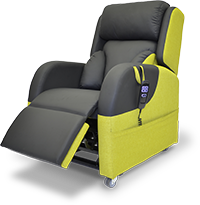When you’re choosing chairs for the elderly, exercise might not be at the top of your mind. But the revitalising and reinvigorating properties of exercise should never be overlooked – even if your elderly users spend the majority of their lives in the chairs you provide. In this guide, Premiere Healthcare outlines some of the simple exercises proven to work well for seated patients.
As elderly chair users are often stationary for long periods of time, exercise is always recommended to aid mobility, blood flow and joint health, as well as strengthening individual muscles. Healthier bodies lead to healthier, happier minds, and greater quality of life. So the value of seated exercise should never be underestimated.
The types of exercise you can realistically expect your patients to perform will, of course, vary depending on their specific health and physical condition. But they typically fall into two categories – self-exercise, which requires no assistance and assisted exercise that requires the additional support of one or two caregivers. Below we list just a few of the many activities that are possible for elderly chair users…
Chest stretch
Your patient sits upright and away from the back of the chair. They then pull their shoulders back and down, extending their arms out to the side. At the same time, they should gently push their chest forward, holding this position for up to 10 seconds.
Seated row
The patient sits towards the edge of their chair, whilst still ensuring they are safe and holds their arms out in front, with thumbs pointing towards the ceiling and the elbows bent. They then perform a ‘rowing’ action, by pulling their elbows back and pressing their shoulder blades together.
Ankle stretch
Sitting upright, the patient holds onto the side of their chair and straightens their left leg with their foot off the floor and toes pointed away from them. They should then point their toes back towards them. This should be repeated with the right foot.
Shoulder rolls
This easy exercise involves sitting up straight in the chair and then ‘shrugging’ the shoulders up toward the ears, rotating them down and back in a circular motion.
Hand squeeze
Your patients hold a ball in front of them and then squeeze their hands together as tightly as possible. By pushing the ball out and then pulling it back toward their chest, elderly chair users can increase the difficulty of the exercise, if they’re able.
Seated march
Great for maintaining or improving mobility and blood flow, this exercise involves lifting first the right knee upwards as if marching and then returning it to its starting position. This motion is then repeated with the left knee.
Upper-body twists
The patient sits with their elbows pulled in tight to their sides and forearms at 90º to the body. They then twist their upper body as far to the left as possible, back to the middle and then to the right. No other part of the body should be moving during this motion – making it idea for strengthening the ‘core’.
Putting a new exercise regime into practice
If you’re thinking about trying some of the exercises mentioned above, and the activity is outside of your usual regime please do seek advice from your Occupational Therapist or GP.
The right advice from specialists in chairs for the elderly
To learn more about specialist chairs for the elderly, or to help you decide which chair solution is right for you and your users, Premiere Healthcare is on hand. As experts in the provision, installation and ongoing servicing of specialist chairs for elderly and disabled users, we can give you a thorough guide to your caregiving options.
We have assessors all over the country who can come out and do home visits free of charge, and bring some chairs along for your user(s) to try on the day.
To book an assessment or find out more, please contact us online or call us on 0345 521 1819.









